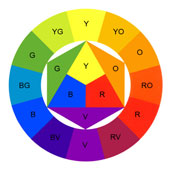Our environment is a world of colour, both natural and manually manipulated. The Oxford Dictionary describes colour as
• “The property possessed by an object of producing different sensations on the eye as a result of the way it reflects or emits light” and
• “One, or any mixture, of the constituents into which light can be separated in a spectrum or rainbow, sometimes including (loosely) black and white.”
Others define it as
• “General term that refers to the wavelength composition of light, with particular reference to its visual appearance.” [1]
Or
• “A phenomenon of light or visual perception that enables one to differentiate otherwise identical objects”. [2]
However, studies so far have shown that colour is not just a physiological reaction, a sensation resulting from different wavelengths on receptors in our eyes, but has an effect on our feelings, behaviour, well-being and preferences as well as choices.
“It is stimulating, calming, expressive, disturbing, impressionable, cultural, exuberant, and symbolic. It pervades every aspect of our lives, embellishes the ordinary, and gives beauty and drama to everyday objects”. Holtzschue, 2002.
“Colour can sway thinking, change actions, and cause reactions. It can irritate or soothe your eyes, raise your blood pressure or suppress your appetite. When used in the right ways, colour can even save on energy consumption”. Morton (www.colourmatter.com)
To this end, the most important functions of colours are to provide visual and psychological information that generates reactions from a viewer. As a powerful form of communication, colour is irreplaceable. Red means “stop” and green means “go.” Traffic lights send this universal message. Likewise, the colours used for a product, packaging, marketing, building interiors, etc. cause powerful reactions. Hence, the artist, architect or designer can provoke various responses and so become the controller of what that viewer perceives. [3]
Though there have been many attempts to discover the appropriate use of colour, defining its meanings and understanding its psycholological effect, there are no defined set of rules for using colours. More important is careful planning, observation and some theoretical knowledge that can aid designers with use of colours.
[1] Merriam Webster Dictionary
[2] Wikipedia
[3] Feisner E.A., Colour: how to use colour in art and design, Laurence King Publishing, 2006.


